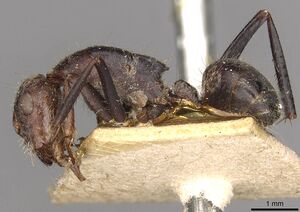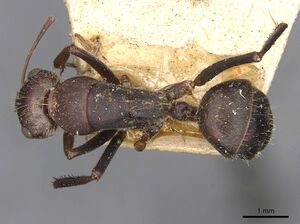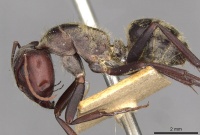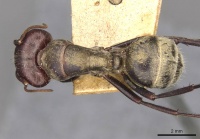Camponotus mendax
| Camponotus mendax | |
|---|---|

| |
| Scientific classification | |
| Kingdom: | Animalia |
| Phylum: | Arthropoda |
| Class: | Insecta |
| Order: | Hymenoptera |
| Family: | Formicidae |
| Subfamily: | Formicinae |
| Tribe: | Camponotini |
| Genus: | Camponotus |
| Species: | C. mendax |
| Binomial name | |
| Camponotus mendax Forel, 1895 | |
| Subspecies | |
| |
| Synonyms | |
| |
Identification
Keys including this Species
Distribution
Latitudinal Distribution Pattern
Latitudinal Range: 34.156971° to 34.156971°.
| North Temperate |
North Subtropical |
Tropical | South Subtropical |
South Temperate |
- Source: AntMaps
Distribution based on Regional Taxon Lists
Oriental Region: India (type locality), Sri Lanka.
Distribution based on AntMaps
Distribution based on AntWeb specimens
Check data from AntWeb
Countries Occupied
| Number of countries occupied by this species based on AntWiki Regional Taxon Lists. In general, fewer countries occupied indicates a narrower range, while more countries indicates a more widespread species. |

|
Estimated Abundance
| Relative abundance based on number of AntMaps records per species (this species within the purple bar). Fewer records (to the left) indicates a less abundant/encountered species while more records (to the right) indicates more abundant/encountered species. |

|
Biology
Castes
Images from AntWeb
   
| |
| Syntype of Camponotus mendax integer. Worker. Specimen code casent0910448. Photographer Z. Lieberman, uploaded by California Academy of Sciences. | Owned by MHNG, Geneva, Switzerland. |
Nomenclature
The following information is derived from Barry Bolton's Online Catalogue of the Ants of the World.
- mendax. Camponotus sericeus var. mendax Forel, 1895e: 454 (s.) INDIA (Karnataka) (date of publication 20.vi.1895).
- Type-material: 2 syntype major workers.
- Type-locality: India: Mysore (= Mysuru) (Lee).
- Type-depository: MHNG.
- Bingham, 1903: 370 (q.).
- Combination in C. (Orthonotomyrmex): Emery, 1925b: 125.
- Subspecies of sericeus: Emery, 1896d 376 (in list); Chapman & Capco, 1951: 242.
- Status as species: Bingham, 1903: 370; Bolton, 1995b: 111; Tiwari, 1999: 70; Karmaly & Narendran, 2006: 86; Bharti, Guénard, et al. 2016: 25; Dias, R.K.S. et al. 2020: 34.
- Senior synonym of pseudolus (unnecessary replacement name): Bolton, 1995b: 111.
- [Note: pseudolus unnecessary as mendax Forel has priority over mendax Emery (Bolton, 1995b: 111).]
- Distribution: India, Sri Lanka.
- Current subspecies: nominal plus integer.
- pseudolus. Camponotus pseudolus Forel, 1907a: 31.
- Status as species: Emery, 1925b: 125.
- Unnecessary replacement name for mendax Forel, 1895e: 454; hence junior synonym of mendax: Bolton, 1995b: 118.
Description
References
- Bingham, C. T. 1903. The fauna of British India, including Ceylon and Burma. Hymenoptera, Vol. II. Ants and Cuckoo-wasps. London: Taylor and Francis, 506 pp. (page 370, queen described)
- Bingham, C. T. 1903. The fauna of British India, including Ceylon and Burma. Hymenoptera, Vol. II. Ants and Cuckoo-wasps. London: Taylor and Francis, 506 pp. (page 370, Raised to species)
- Dhadwal, T., Bharti, H. 2023. Two new species of the genus Camponotus Mayr, 1861 (Hymenoptera: Formicidae) with five new records from India. European Journal of Taxonomy 901, 1-51 (doi:10.5852/ejt.2023.901.2317).
- Emery, C. 1925d. Hymenoptera. Fam. Formicidae. Subfam. Formicinae. Genera Insectorum 183: 1-302 (page 125, Combination in C. (Orthonotomyrmex))
- Forel, A. 1895f. Les Formicides de l'Empire des Indes et de Ceylan. Part V. J. Bombay Nat. Hist. Soc. 9: 453-472 (page 454, soldier described [Date of publication 20.vi.1895.] )
References based on Global Ant Biodiversity Informatics
- Dias R. K. S. 2002. Current knowledge on ants of Sri Lanka. ANeT Newsletter 4: 17- 21.
- Dias R. K. S. 2006. Current taxonomic status of ants (Hymenoptera: Formicidae) in Sri Lanka. The Fauna of Sri Lanka: 43-52. Bambaradeniya, C.N.B. (Editor), 2006. Fauna of Sri Lanka: Status of Taxonomy, Research and Conservation. The World Conservation Union, Colombo, Sri Lanka & Government of Sri Lanka. viii + 308pp.
- Dias R. K. S., K. R. K. A. Kosgamage, and H. A. W. S. Peiris. 2012. The Taxonomy and Conservation Status of Ants (Order: Hymenoptera, Family: Formicidae) in Sri Lanka. In: The National Red List 2012 of Sri Lanka; Conservation Status of the Fauna and Flora. Weerakoon, D.K. & S. Wijesundara Eds., Ministry of Environment, Colombo, Sri Lanka. p11-19.
- Mackay, W., and E. Mackay. The ants of New Mexico. The Edwin Mellen Press, 2002.
- Presty J., and K. A. Karmaly. 2016. A study on the diversity and distribution of genus Camponotus Mayr (Hymenoptera: Formicidae) in Kerala: ecologically significant agents in ecosystems functioning. In: Chakravarhty A. K, and S. Sridhara (eds), Arthropod diversity and conservation in the tropics and sub-tropics. Springer edition. Pages 255-270.

